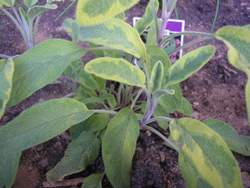|
Sage Plant Benefits

The garden sage plant, Salvia officinalis, is useful for treating depression, stress and anxiety. Six of Sage’s phytochemicals are anti-depressants, two are anti-anxiety and one provides anti-stress protection. Many more are anti-viral and anti-bacterial to aid in fighting against infections, flus and colds. Although Sage must not be used by pregnant women, its medicinal qualities make it a valuable asset in maintaining good health for the rest of us. It can be an aid to losing weight, recovering from alcoholism, reducing high sugar levels in the blood and lowering acidity in the body (acidosis). During PMS-PMT, relief can be obtained with Sage as a mild diuretic, as it reduces bloating. It can bring on menstruation delayed due to stress, and serve as a pick-me-up for lethargia and fatigue. The cleansing and antioxidant properties of Salvia officinalis make it extremely useful in detoxification, smudging ceremonies and during convalescence when it stimulates the immune system to further healing. It may aid in times of shock and stress. As a preventative medicine, the sage herb has chemicals that have been proven to counter the effects of Staph infections, allergies, menopause, atherosclerosis, Herpes simplex, arthritis, Candida albicans, psoriasis, osteoporosis, and as a mouthwash can be very effective in cases of gingivitis, mouth and gum sores. How to use Sage teaUse the leaves in teas, infusions and to make tinctures or glycerines. Use sage tea to treat headaches, anxiety and tension, insomnia, coughs, indigestion and fever. Sage tea can also be cooled and used as a wash to treat skin irritations and bites, skin abrasions, bruises and inflammation. Sage should not be taken on a regular basis due to its high thujone content. Growing SageSage works wonders in the garden as an attractant for bees and butterflies, and a repellent for aphids, white cabbage moth, carrot fly and ants. Sage grows as a compact shrub with soft grey-green leaves and blue-purple flowers. If you’re growing sage plants amongst other herbs, grow it towards the back as it can get quite tall, unless you’re going to keep it small with frequent use. Sage plants prefer full sun and grow in most soils, and will also do well in medium to large pots. You can grow sage from seed in Spring, cuttings in Spring and Autumn or by layering stems in Spring or Summer. Safe use of herbsWe do not diagnose or prescribe, and we strongly urge you to see your healthcare professional if you are suffering from any condition or chronic illness. Herbs can be dangerous if not identified or used correctly. Herbs do not replace advice or treatment from your healthcare professional. Please read this important caution regarding the safe use of herbs. Sage’s phytochemicals and phytochemical properties are selectively cited by the author from the Dr. Duke's Phytochemical and Ethnobotanical Databases, http://www.ars-grin.gov/duke/plants.html, Jim Duke and Mary Jo Bogenschutz. Back to Growing Herbs from Sage Plant Benefits
Back to Healthy Eating Guide home from Sage Plant Benefits
|









